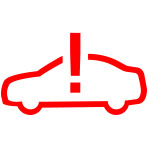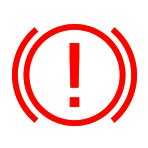Checking electric vehicle driving information
During vehicle operation, the instrument cluster displays the main information, such as distance to empty, real-time energy status, battery charge level, and warning messages, via the user interface and indicators.
The distance to empty refers to the distance that can be driven by the current charged battery level and is displayed on the bottom of the instrument cluster while driving the electric vehicle.
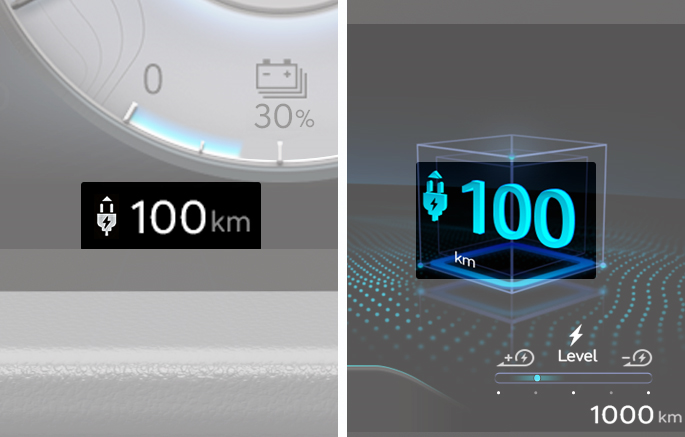
2C_DistanceToEmpty
The distance to empty vary depending on many factors such as driving habits, power usage, driving conditions, and high voltage battery. The distance to empty may be increased or decreased than the certified figures as it reflects all the factors comprehensively. Check the distance to empty considering the following:
-
The driving habits: The driving speed and tendency of accelerating and decelerating. High-speed driving or frequent accelerating and decelerating reduces the distance to empty.
-
The power usage: Additional power use, such as the air conditioner, heater, lamps, etc. As the power usage increases, the distance to empty reduces.
-
The driving conditions: The weather, temperature, and terrain. If you drive in snow/rain/strong wind or low temperature, the distance to empty will be reduced. The distance to empty will also be reduced when driving uphill or on slippery or rough roads.
-
The electric energy: Proportional to the State of Charge (SOC), but may vary depending on the battery temperature and the State of Health (SOH) of a battery.
In case the distance to empty has been reduced due to learning of the driving habit or the driving conditions, you can increase the distance to empty again by continuously driving following the "Tips for enhancing the distance to empty".
-
Resetting the previously learned driving patterns at the service center may increase the distance to empty displayed on the bottom of the instrument cluster, but it does not increase the actual distance to empty. The distance to empty may not be accurate until the learning proceeds.
-
If the high voltage battery temperature is low in winter, the distance to empty reduces but it is not a permanent change. The distance to empty may increase again once the temperature rises.
-
If you reduce the power usage, the distance to empty may increase.
-
Natural degradation may occur with the high voltage battery depending on the number of years the vehicle is used. This may reduce the distance to empty.
When the destination is set, the distance to empty may change because the distance to empty is recalculated using the information of the destination instead of the learned electric energy economy history.
The distance to empty may vary significantly based on traffic conditions or driving speed.
The distance to empty vary depending on the charge level of the high voltage battery, weather, temperature, duration of the battery use, terrain, driving habits, etc.
You can increase the distance to empty by driving the vehicle following the instructions below.
-
The air resistance increases rapidly as the electric vehicle drives faster, so avoid speeding to increase the distance to empty and the electric energy economy.
-
Rapid acceleration consumes a lot of driving energy and rapid deceleration limits the regenerative braking. Gradually depress and release the accelerator pedal when accelerating or decelerating to maintain speed.
-
If you operate the air conditioner or heater too much, the high voltage battery uses excessive electricity. This may reduce the distance to empty. Therefore, set the cabin temperature to 22 °C (71.6 °F) AUTO level 2. Especially in winter, reducing heating and using heated seats instead can significantly increase the distance to empty. Turn off the air conditioner or heater if you do not need them.
-
When using the air conditioner or heater, the energy consumption is reduced if recirculation mode is selected instead of fresh mode. Fresh mode requires a large amount of energy consumption as the outside air has to be reheated or cooled.
-
Close the windows while driving. Driving with the windows open increases air resistance and the usage of the air conditioner or heater.
-
When using the air conditioner or heater while driving alone, use the DRIVER ONLY function.
-
Always maintain specified tire pressures and use tires for electric vehicles.
-
Do not use unnecessary electrical components while driving.
-
Do not load unnecessary items in the vehicle.
-
Do not mount parts that may increase air resistance.
-
When the battery warning indicator is displayed, immediately charge the vehicle at a nearby charging station.
-
Drive energy efficiently following the "Tips for enhancing the distance to empty."
-
When the battery level is 0 %, do not try to drive. Move to a safe place and call for help.
The CHARGE/POWER gauge displays the charging and discharging status of the electric energy produced by the regenerative braking and the energy consumption of the electric motor.
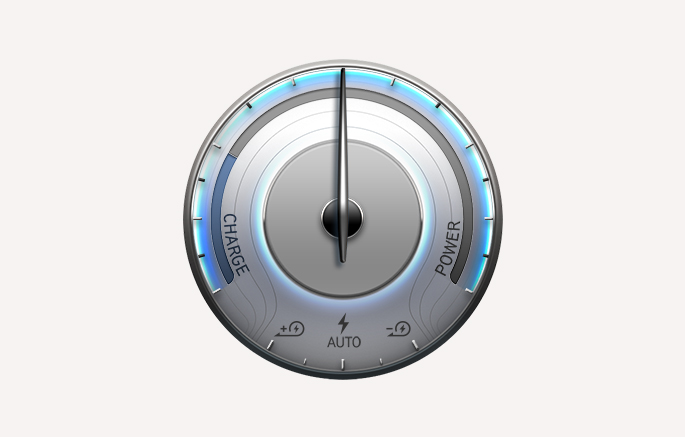
2C_PowerChargeGauge
-
CHARGE: It shows the charging status of the battery, which is charged by the generative brakes, when depressing the brake pedal or decreasing the vehicle speed due to coasting. The more electric energy is charged, the more the gauge level turns counterclockwise.
-
POWER: It shows the discharging status of the motor when the vehicle is accelerating. The more electric energy is discharged (used), the more the gauge level turns clockwise.
The SOC indicator is displayed at the bottom of the CHARGE/POWER gauge and shows the charge level of the high voltage battery as a percentage. The lower the number, the more the vehicle needs to be charged, and 100 % indicates a full charge.
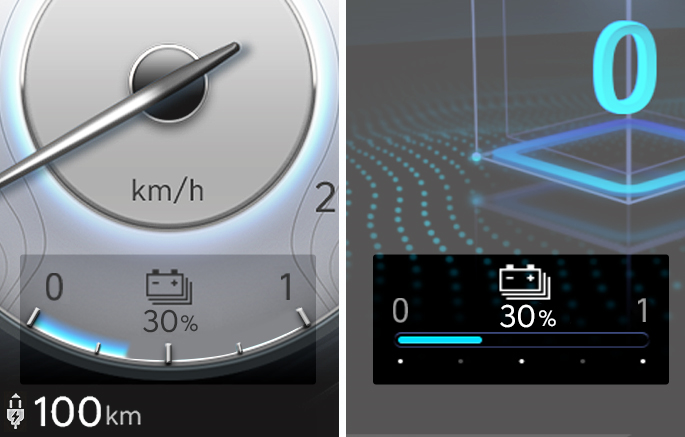
2C_ChargingLevelIndicator
The SOC indicator shows the state of charge of the high-voltage battery
-
When the high voltage battery level is below a certain point, its warning light (
ª ) illuminates. -
When the warning light is displayed, charge the vehicle.
Battery capacity warning level
-
Long Range: 20 %
-
Standard: 25 %
-
Cross: 20 %
-
Check if the SOC is enough before driving on highways or motorways.
-
After the warning light is displayed, immediately charge the vehicle at a nearby charging station. The vehicle may not operate properly depending on the driving speed, weather, and other driving conditions.
The warning and indicator lights are displayed in the middle of the instrument cluster before or while driving, depending on the status of the electric vehicle. Understand the meaning of the warning and indicator lights referring to the instructions below and drive safely.
If the warning light illuminates while driving or does not go off, we recommend that your vehicle be inspected by an authorized HYUNDAI dealer.
Checking the warning lights
Check the cause of the warning lights referring to the table below and take appropriate measures.
|
Warning light |
Cause |
Measure |
|
Service warning light
|
This warning light illuminates:
|
In a normal condition, it illuminates for about 3 seconds when the Start/Stop button is in the ON position and then goes off.
|
|
High voltage battery level warning light
|
This warning light illuminates when the high voltage battery level is low. |
Immediately charge the vehicle. The vehicle can drive an additional 30-50 km (20-30 mi).
|
|
Regenerative brake warning light
|
This warning light illuminates when the regenerative brake does not operate and the brake does not perform well due to the malfunction of the brake system. |
We recommend that your vehicle be inspected and repaired by an authorized HYUNDAI dealer
|
Checking the indicator lights
Check the meaning of the indicator lights referring to the table below and take appropriate measures if necessary.
|
Indicator light |
Meaning |
|
Charging indicator light
|
Indicates the charging connector is connected to the high voltage battery.
|
|
Ready indicator
|
Illuminates when the electric vehicle is ready to be driven, and indicates that the vehicle is operable.
|
|
Power down indicator light
|
This indicator light illuminates:
If it illuminates alone, it is not failure.
|
Checking warning messages
Check the meaning of the warning messages referring to the table below and take appropriate measures.
-
Do not drive with a warning message displayed.
-
If a warning message does not go off after taking measures, we recommend that you have the vehicle immediately inspected and repaired by an authorized HYUNDAI dealer.
|
Warning message |
Cause |
Measure |
|
Low EV battery |
|
Charge the vehicle immediately. |
|
Charge immediately. Power limited |
|
Charge the battery immediately. |
|
Check electric vehicle system |
There is a problem with the electric vehicle control system. |
|
|
Power limited |
This warning message is displayed when the power of the vehicle is limited to ensure the safety of high-powered components for the reasons below:
|
If it illuminates alone, it did not fail.
|
|
Power limited. Low battery temperature |
If you start or turn off the vehicle when the outside temperature is low, warning message is displayed to protect electric vehicle system.
|
|
|
Battery overheated! Stop safely |
The high voltage battery temperature is too high. |
|
|
Stop safely and check power supply |
A failure occurs in the power supply system. |
Immediately stop the vehicle in a safe place. We recommend that you tow the vehicle to an authorized HYUNDAI dealer for inspection and maintenance. |
|
Unplug vehicle to start |
You started the vehicle with the charging connector plugged in. |
Unplug the charging cable and start the vehicle. |
|
Charging door open |
You started the vehicle with the charging door opened. |
Check if the charging door is completely closed after charging the vehicle. |
|
Charging stopped. Please check the AC(DC) charger |
These warning messages are displayed when charging is stopped for the reasons below:
|
|
|
Charging interrupted. Please check the cable connection |
These warning message is displayed when charging is stopped for the reasons below:
|
|
